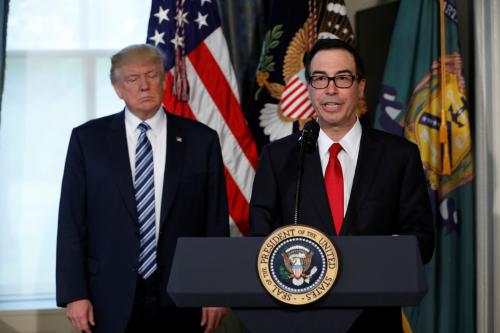Former Federal Reserve governor Jeremy Stein, now back at Harvard, and three of his colleagues say big banks have a good point: Post-crisis rules on capital are way too complicated and are having unwelcome, unintended consequences. The largest U.S. banks, they figure, have to comply with at least 10 distinct capital requirements.
But the banks probably won’t like their solution: Simplify capital rules without reducing the amount of capital banks are required to hold and give regulators lots of maneuvering room at times of crisis, including the power to prevent banks from paying dividends.
In a paper presented at Brookings on Sept. 8 as part of the Brookings Papers on Economic Activity, Mr. Stein and his co-authors – Robin Greenwood, Samuel Hanson and Adi Sunderam – argue that overlapping rules setting minimum bank capital cushions discourage banks from specializing in what they do well. That, they say, is creating inefficiencies that hurt the economy.
In essence, they seek to preserve the intended consequences of the tougher bank capital requirements imposed after the financial crisis and reduce the unintended consequences.
(The more capital a bank has, the greater the losses it can absorb without causing problems for other banks or needing government aid. One big reason the 2007-08 financial crisis was so severe is that banks didn’t hold nearly enough capital given the risks we now know they were taking and the negative spillovers to the financial system and the overall economy.)
Here’s the problem, as they see it: Some banks, the ones that do a lot of consumer and business lending such as Wells Fargo and U.S. Bancorp, are effectively constrained by rules that require them to hold a certain amount of capital based on their assets, adjusted for the riskiness of those loans and other assets. Banks that do more trading, such as Goldman Sachs and Morgan Stanley, are effectively constrained by a different rule, the “supplemental leverage ratio” which calibrates capital requirements to a bank’s total on- and off-balance sheet exposures, without any adjustment for risks.
As an example, Mr. Greenwood observes Wells Fargo doesn’t have to hold any additional capital when it buys U.S. Treasurys – or accepts Treasury debt as collateral in a repurchase agreement (repo)– because U.S. Treasury debt is considered basically risk-free under the rules that are binding for that bank. But for the same repo transaction, Goldman would have to hold additional capital on the margin. So Goldman, which may be better at the repo business, does less and Wells does more.
That, the authors say, is foolish. “Economic logic does not support having multiple independent constraints on bank equity ratios,” the economists say. It’s like imposing different marginal tax rates on different manufacturers with exactly the same process and product.
Their solution is to streamline the capital rules into a single risk-based constraint, one that reflects the findings of stress tests that regulators conduct regularly to gauge the losses a bank would suffer if the economy deteriorates. In some respects, the proposals resemble those made by another former Fed governor, Daniel Tarullo (who will comment on the paper at BPEA), and Nellie Liang, a former top Fed staffer now at Brookings.
The authors add a few conditions, however. One, they aren’t arguing for less capital. “We think it would be a mistake if bank capital was allowed to decline to any meaningful extent, and we suspect adding a few more percentage points to risk-based capital ratios, especially for the biggest banks, would be socially beneficially.” Bigger banks should hold more capital than smaller ones; failure of a bigger bank can do a lot more damage to the economy.
Two, they’d give regulators more discretion than banks would like in devising the stress tests, recognizing that banks are skilled at finding ways around precisely fixed rules. They side with regulators in their determination to keep the details of the models used in stress testing confidential before the exercise, but recommend more transparency after the stress tests are conducted. It’s a bit like a professor showing students the exam he used last year, but warning that this year’s exam will be different.
Three, they want regulators to be able to force banks to conserve or raise capital in the early stages of a financial crisis. As other analysts have, the authors say it was a mistake to let the largest banks pay $125 billion in dividends between the beginning of 2007 and the third quarter of 2008, reducing the capital they had to absorb the $375 billion in loans they eventually wrote off. They want to avoid a repeat of that.







Commentary
Former Fed Governor Stein and colleagues: Simplify, but don’t dilute, bank capital standards
September 7, 2017